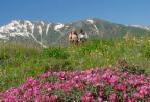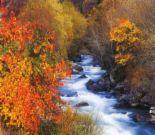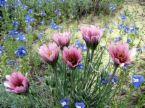Kazakhstan
Land
 Kazakhstan covers an area of 2,717,300 sq km (1,049,155 sq mi), making it by far the largest country in Central Asia. It was the second largest republic of the former Soviet Union, after Russia. Although high mountain ranges fringe
Kazakhstan covers an area of 2,717,300 sq km (1,049,155 sq mi), making it by far the largest country in Central Asia. It was the second largest republic of the former Soviet Union, after Russia. Although high mountain ranges fringe  the republic’s eastern and southeastern borders, the terrain of Kazakhstan consists mostly of deserts, steppes (vast, semiarid grassy plains), and hilly upland areas. Deserts and semideserts (such as stone, salt, and sand wastelands) cover more than two-thirds of Kazakhstan’s surface area.
the republic’s eastern and southeastern borders, the terrain of Kazakhstan consists mostly of deserts, steppes (vast, semiarid grassy plains), and hilly upland areas. Deserts and semideserts (such as stone, salt, and sand wastelands) cover more than two-thirds of Kazakhstan’s surface area.  The most expansive deserts in the republic are the sandy, barren Qyzylqum, which also occupies part of Uzbekistan, and the clay-crusted Betpak-Dala; both are located in the southern portion of the republic.
The most expansive deserts in the republic are the sandy, barren Qyzylqum, which also occupies part of Uzbekistan, and the clay-crusted Betpak-Dala; both are located in the southern portion of the republic.
 country’s highest point, Hantengri (6,398 m/20,991 ft), which lies in the extreme southeast where the borders of Kazakhstan, Kyrgyzstan, and China meet. The Altay Mountains along the country’s eastern border also contain high peaks. Kazakhstan’s lowest elevation is found in the extreme southwest, just east of the Caspian Sea, where the
country’s highest point, Hantengri (6,398 m/20,991 ft), which lies in the extreme southeast where the borders of Kazakhstan, Kyrgyzstan, and China meet. The Altay Mountains along the country’s eastern border also contain high peaks. Kazakhstan’s lowest elevation is found in the extreme southwest, just east of the Caspian Sea, where the  Karagiye Depression lies 132 m (433 ft) below sea level. The area north of the Caspian, in northwestern Kazakhstan, is occupied by the Caspian Depression, which also extends into Russia.
Karagiye Depression lies 132 m (433 ft) below sea level. The area north of the Caspian, in northwestern Kazakhstan, is occupied by the Caspian Depression, which also extends into Russia.Water Resources
Rivers
 Kazakhstan contains an extensive network of rivers. Many of Kazakhstan’s rivers drain within the republic, although the Ishim, Irtysh, and Tobol rivers flow north into Russia and eventually drain into the Arctic Ocean. Due to dry weather conditions, the riverbeds of most of the republic’s small and
Kazakhstan contains an extensive network of rivers. Many of Kazakhstan’s rivers drain within the republic, although the Ishim, Irtysh, and Tobol rivers flow north into Russia and eventually drain into the Arctic Ocean. Due to dry weather conditions, the riverbeds of most of the republic’s small and  medium-sized rivers remain dry for much of the year. One of Kazakhstan’s largest rivers, the Syr Darya, enters Kazakhstan in the south and follows a northwesterly course toward the northern portion of the Aral Sea, a saltwater lake that straddles Kazakhstan’s border with Uzbekistan.
medium-sized rivers remain dry for much of the year. One of Kazakhstan’s largest rivers, the Syr Darya, enters Kazakhstan in the south and follows a northwesterly course toward the northern portion of the Aral Sea, a saltwater lake that straddles Kazakhstan’s border with Uzbekistan.
 The Ural River, which flows south from Russia, enters northwestern Kazakhstan and drains into the Caspian Sea, a saltwater lake that is the largest inland body of water in the world.
The Ural River, which flows south from Russia, enters northwestern Kazakhstan and drains into the Caspian Sea, a saltwater lake that is the largest inland body of water in the world.
Lakes and Dams
 There are more than 17,000 natural lakes in Kazakhstan, with a total area of about 45,000 km2 and a total volume of water estimated at about 190 km3. Salinity varies from 0.12 grams/liter in east Kazakhstan to 2.7 grams/liter in the central part of the country. More than 4,000 lakes are inventoried as saline. The largest lakes are: Lake Balkhash, with an area of 18,000 km2 and a volume of 112 km3; Lake Zaisan, with an area of about 5,500 km2; and Lake Tengiz, with an area of 1,590 km2. Irrigation development in the last 20 years in the basin of the Ili River, which flows into Lake Balkhash, has led to ecological problems in the region, notably the drying up of small lakes. For the whole country, it is estimated that about 8,000 small lakes have dried up in the recent past due to overexploitation of water resources.
There are more than 17,000 natural lakes in Kazakhstan, with a total area of about 45,000 km2 and a total volume of water estimated at about 190 km3. Salinity varies from 0.12 grams/liter in east Kazakhstan to 2.7 grams/liter in the central part of the country. More than 4,000 lakes are inventoried as saline. The largest lakes are: Lake Balkhash, with an area of 18,000 km2 and a volume of 112 km3; Lake Zaisan, with an area of about 5,500 km2; and Lake Tengiz, with an area of 1,590 km2. Irrigation development in the last 20 years in the basin of the Ili River, which flows into Lake Balkhash, has led to ecological problems in the region, notably the drying up of small lakes. For the whole country, it is estimated that about 8,000 small lakes have dried up in the recent past due to overexploitation of water resources.
Plants and Animals
Forested areas amount to only 1 percent of Kazakhstan’s territory, as the steppes and deserts are virtually treeless. Drought-resistant plants such as wormwood, tamarisk (salt cedar), and feather grass are native to the steppes, although grain crops have largely supplanted native vegetation in the northern steppes. Scrub plants are common in the Qyzylqum desert. Thickets of elm, poplar, reeds, and shrubs grow along the banks of rivers and lakes. Coniferous trees, such as spruce, larch, cedar, and juniper, grow in thick forests on the mountain slopes in the extreme east and southeast.
Natural Resources
Only 8 percent of Kazakhstan is cultivated, and the northern steppes are the most intensely farmed area. Kazakhstan contains vast mineral resources, with significant deposits of coal, iron ore, manganese, bauxite, chromium, tungsten, uranium, and other minerals. Kazakhstan also has large reserves of petroleum and natural gas in the western Caspian Sea area.
Document Actions
